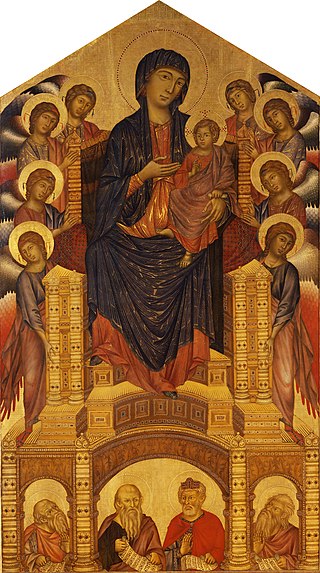
Santa Cristina is a Neoclassical-style, Roman Catholic church in Pisa, region of Tuscany, Italy. It is located on the Lungarno Gambacorti.

Santa Cristina is a Neoclassical-style, Roman Catholic church in Pisa, region of Tuscany, Italy. It is located on the Lungarno Gambacorti.
The church is documented since the 9th century, but the apse area is from the 10th-11th century. Destroyed by a flood in 1115, it was rebuilt three years later. [1]
The Count Luigi Archinto, member of a prominent Milanese family, had moved to Pisa in the late 18th century, and in 1814, he had acquired the Agnello palace adjacent to this church. He then patronized and commissioned the reconstruction of the church, which by then was in poor conservation. He commissioned the works from the engineer Francesco Riccetti, who also restored the bell tower. [2]
The interior layout is that of a single nave, refurbished with neoclassical decorations. It houses a panel with Madonna and Child (14th century).
The first altar on the right has canvas by Domenico Passignano, depicting St Catherine Receiving the Stigmata, and a 19th-century copy of Enrico di Tedice's Crucifix (13th century). In this spot, with the earlier crucifix, was the one before which, in 1375, St Catherine of Siena, kneeling in prayer, had received the stigmata. Catherine had been invited to Pisa to help pacify some of the civic strife. [3]

Giovanni Cimabue, c. 1240 – 1302, was an Italian painter and designer of mosaics from Florence. He was also known as Cenni di Pepo or Cenni di Pepi.

Santa Maria Novella is a church in Florence, Italy, situated opposite, and lending its name to, the city's main railway station. Chronologically, it is the first great basilica in Florence, and is the city's principal Dominican church.

Giunta Pisano was an Italian painter. He is the earliest Italian painter whose name is found inscribed on an extant work. He is best known for his crucifixes.

La Verna is a locality on Mount Penna, an isolated mountain of 1,283 metres (4,209 ft) situated in the centre of the Tuscan Apennines, rising above the valley of the Casentino, central Italy. The place is known especially for its association with Saint Francis of Assisi and for the Sanctuary of La Verna, which grew up in his honour. Administratively it falls within the Tuscan province of Arezzo and the comune of Chiusi della Verna, Italy.

The Basilica of Saint Mary of the Angels is a papal minor basilica situated in the plain at the foot of the hill of Assisi, Italy, in the frazione of Santa Maria degli Angeli.

The Tempio Malatestiano is the unfinished cathedral church of Rimini, Italy. Officially named for St. Francis, it takes the popular name from Sigismondo Pandolfo Malatesta, who commissioned its reconstruction by the famous Renaissance theorist and architect Leon Battista Alberti around 1450.

San Piero a Grado is a church in Pisa, Tuscany, Italy, in the eponymous frazione 7 kilometres (4.3 mi) west of the city center. The church is located where once was a now disappeared port of the Pisan Republic, where, according to the legend, St. Peter landed in Italy from Antiochia in 44 AD.

San Paolo a Ripa d'Arno is a Roman Catholic church in Pisa, region of Tuscany, Italy. It is a pre-eminent example of Tuscan Romanesque church architecture. The church is also locally known as Duomo vecchio.

San Francesco de' Ferri is a church in Pisa, Tuscany, Italy.

Santa Caterina d'Alessandria is a Gothic-style Roman Catholic church in Pisa, Tuscany, Italy.

The Basilica of San Domenico, also known as Basilica Cateriniana, is a basilica church in Siena, Tuscany, Italy, one of the most important in the city. The basilica is an example of Cistercian Gothic style.

Benedetto Buglioni (1459/1460–1521) was an important Italian Renaissance sculptor specialised in glazed terracotta.

The Basilica dell'Osservanza is a church on the outskirts of Siena, region of Tuscany, Italy.

Santa Apollonia is a church in Pisa, Italy.

San Michele degli Scalzi is a church located in Piazza San Michele degli Scalzi, in the eastern part of Pisa, Italy. It had also been known as the church of San Michele degli Scalzi in Orticaia, referring to the swampy nature of the site at the time of its founding. The term Scalzi refers to the barefoot monks linked to the church. Dating back to the 11th century, it has been restored several times in the original Romanesque style.

San Giorgio ai Tedeschi is a Roman Catholic church located in the centre of Pisa, Italy.

Santa Maria in Provenzano, or the Insigne Collegiata di Santa Maria in Provenzano, is a late-Renaissance-Baroque style, Roman Catholic, collegiate church in Piazza Provenzano Salvani, in the Terza Camollia, just southwest of the basilica of San Francesco, in the city of Siena, region of Tuscany, Italy. This Marian shrine was built around a 14th-century terracotta icon of the Madonna, which was credited with miracles. The Palio of Siena takes place on the day of veneration of this Marian devotion.

Santa Croce in Fossabanda is a Renaissance-style Roman Catholic church and monastery in Pisa, region of Tuscany, Italy.

Sant'Agostino is a Romanesque-Gothic-style Roman Catholic church located in Via Cairoli in Rimini, Italy. It is one of the city's oldest extant church buildings.

Santi Stefano e Niccolao or Stefano e Nicolò is a Roman Catholic church located in Pescia, region of Tuscany, Italy.